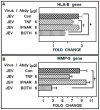Infection of human endothelial cells by Japanese encephalitis virus: increased expression and release of soluble HLA-E
- PMID: 24236107
- PMCID: PMC3827286
- DOI: 10.1371/journal.pone.0079197
Infection of human endothelial cells by Japanese encephalitis virus: increased expression and release of soluble HLA-E
Abstract
Japanese encephalitis virus (JEV) is a single stranded RNA virus that infects the central nervous system leading to acute encephalitis in children. Alterations in brain endothelial cells have been shown to precede the entry of this flavivirus into the brain, but infection of endothelial cells by JEV and their consequences are still unclear. Productive JEV infection was established in human endothelial cells leading to IFN-β and TNF-α production. The MHC genes for HLA-A, -B, -C and HLA-E antigens were upregulated in human brain microvascular endothelial cells, the endothelial-like cell line, ECV 304 and human foreskin fibroblasts upon JEV infection. We also report the release/shedding of soluble HLA-E (sHLA-E) from JEV infected human endothelial cells for the first time. This shedding of sHLA-E was blocked by an inhibitor of matrix metalloproteinases (MMP). In addition, MMP-9, a known mediator of HLA solubilisation was upregulated by JEV. In contrast, human fibroblasts showed only upregulation of cell-surface HLA-E. Addition of UV inactivated JEV-infected cell culture supernatants stimulated shedding of sHLA-E from uninfected ECV cells indicating a role for soluble factors/cytokines in the shedding process. Antibody mediated neutralization of TNF-α as well as IFNAR receptor together not only resulted in inhibition of sHLA-E shedding from uninfected cells, it also inhibited HLA-E and MMP-9 gene expression in JEV-infected cells. Shedding of sHLA-E was also observed with purified TNF-α and IFN-β as well as the dsRNA analog, poly (I:C). Both IFN-β and TNF-α further potentiated the shedding when added together. The role of soluble MHC antigens in JEV infection is hitherto unknown and therefore needs further investigation.
Conflict of interest statement
Figures








Similar articles
-
Infection of human amniotic and endothelial cells by Japanese encephalitis virus: Increased expression of HLA-F.Virology. 2014 Dec;471-473:29-37. doi: 10.1016/j.virol.2014.09.022. Epub 2014 Oct 20. Virology. 2014. PMID: 25461528
-
Inhibition of ERK and proliferation in NK cell lines by soluble HLA-E released from Japanese encephalitis virus infected cells.Immunol Lett. 2014 Nov;162(1 Pt A):94-100. doi: 10.1016/j.imlet.2014.07.010. Epub 2014 Jul 30. Immunol Lett. 2014. PMID: 25086398
-
IP-10 Promotes Blood-Brain Barrier Damage by Inducing Tumor Necrosis Factor Alpha Production in Japanese Encephalitis.Front Immunol. 2018 May 30;9:1148. doi: 10.3389/fimmu.2018.01148. eCollection 2018. Front Immunol. 2018. PMID: 29910805 Free PMC article.
-
Regulatory role of TRIM21 in the type-I interferon pathway in Japanese encephalitis virus-infected human microglial cells.J Neuroinflammation. 2014 Feb 1;11:24. doi: 10.1186/1742-2094-11-24. J Neuroinflammation. 2014. PMID: 24485101 Free PMC article.
-
Molecular Mechanism and Role of Japanese Encephalitis Virus Infection in Central Nervous System-Mediated Diseases.Viruses. 2022 Nov 30;14(12):2686. doi: 10.3390/v14122686. Viruses. 2022. PMID: 36560690 Free PMC article. Review.
Cited by
-
Alternative splicing and genetic variation of mhc-e: implications for rhesus cytomegalovirus-based vaccines.Commun Biol. 2022 Dec 19;5(1):1387. doi: 10.1038/s42003-022-04344-2. Commun Biol. 2022. PMID: 36536032 Free PMC article.
-
Defining the role of NK cells during dengue virus infection.Immunology. 2018 Mar 23;154(4):557-62. doi: 10.1111/imm.12928. Online ahead of print. Immunology. 2018. PMID: 29570783 Free PMC article. Review.
-
Natural killer (NK) cells in bipolar disorders.Neurosci Appl. 2024 Apr 11;3:104066. doi: 10.1016/j.nsa.2024.104066. eCollection 2024. Neurosci Appl. 2024. PMID: 40656111 Free PMC article. Review.
-
EGFR Activation Impairs Antiviral Activity of Interferon Signaling in Brain Microvascular Endothelial Cells During Japanese Encephalitis Virus Infection.Front Microbiol. 2022 Jun 30;13:894356. doi: 10.3389/fmicb.2022.894356. eCollection 2022. Front Microbiol. 2022. PMID: 35847084 Free PMC article.
-
Ezrin is essential for the entry of Japanese encephalitis virus into the human brain microvascular endothelial cells.Emerg Microbes Infect. 2020 Dec;9(1):1330-1341. doi: 10.1080/22221751.2020.1757388. Emerg Microbes Infect. 2020. PMID: 32538298 Free PMC article.
References
-
- Kabilan L, Rajendran R, Arunachalam N, Ramesh S, Srinivasan S, et al. (2004) Japanese encephalitis in India: an overview. Indian J Pediatr 71: 609–615. - PubMed
-
- van den Hurk AF, Ritchie SA, Mackenzie JS (2009) Ecology and geographical expansion of Japanese encephalitis virus. Annu Rev Entomol 54: 17–35. - PubMed
-
- Lindenbach BD, Rice CM (2003) Molecular biology of flaviviruses. Adv Virus Res 59: 23–61. - PubMed
-
- Kurane I (2002) Immune responses to Japanese encephalitis virus. Curr Top Microbiol Immunol 267: 91–103. - PubMed
Publication types
MeSH terms
Substances
LinkOut - more resources
Full Text Sources
Other Literature Sources
Research Materials
Miscellaneous

